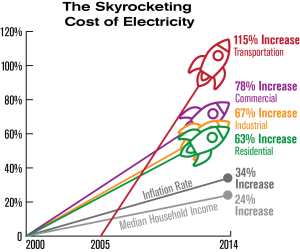Understanding how to reduce your electricity bill can be as simple as figuring out what consumes the most energy. You should use a simple formula to determine how many kilowatt-hours (kWh) a device uses per month or year, and then find ways to reduce consumption. For the Electricity Rates this is important.
A kilowatt-hour is a way of measuring how much energy a device consumes per hour of operation. Most appliances provide power or a range of powers at which the device operates how many watts burn out in an hour. Once you know this power, simply divide it by 1000 (to convert to kilowatts), and then multiply by the number of hours you use per day. This will give you basic information about how many kilowatt-hours per day you use with this item.
Then you can use the data of the US Department of Energy for the average utility tariff – $ 0.12, or get more accurate information and find out the price directly from your energy supplier. Based on the costs, you can determine which device or devices is the actual energy vampire, and which actually does not consume a lot of electricity.

‘Random’ electricity consumers
There are also devices that consume electricity even after they are turned off and this is the main problem. You should know how much power the device actually continues to consume, even when it is not turned on. It can be a computer, an instant-on television, a speaker system, or even cable and satellite TV. In this regard, everything that has a built-in digital clock is a bit, but it draws electricity.
According to estimates by the National Council for the Protection of Natural Resources, nearly a quarter of the energy used by your home is consumed by idle devices that are not even turned on. It is estimated that the average family in Northern California spends between $ 210 and $ 440 per year on energy vampires, and residents of the country as a whole spend $ 19 billion a year on electricity that they don’t actually use.
What can be done? Unplug things you don’t use, exclude power strips for devices, they consume electricity during downtime, configure power options for things such as a computer or TV, and consider installing timers for outlets they will help control the use of electricity.
Audio and video equipment
When leaving home for a long time or going to bed at night, turn off not only the lights but also the electrical appliances that are in the “standby” mode standby mode: TV, stereo, DVD player. This measure will also increase the fire safety of your home.
Attention
Do not dispose of spent fluorescent lamps including energy-saving ones in the trash chute and street containers. Try not to break the fluorescent tubes. Fluorescent lamps contain a small amount of mercury vapor, which is harmful to humans only if the lamp is broken.
Electric stove
When choosing cookware for cooking that does not correspond to the size of the hotplate, 5-10% of energy is lost. To save energy when using electric stoves, use cookware with an undistorted bottom that is equal to or slightly larger than the diameter of the burner. When cooking, cover the pan with a lid. The rapid evaporation of water lengthens the cooking time by 20-30%, and, accordingly, the energy consumption for cooking increases by the same amount.

